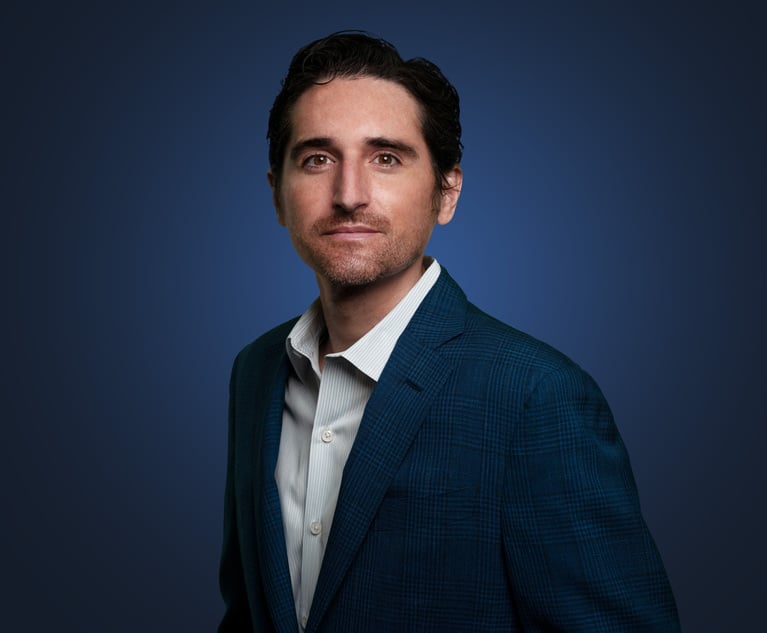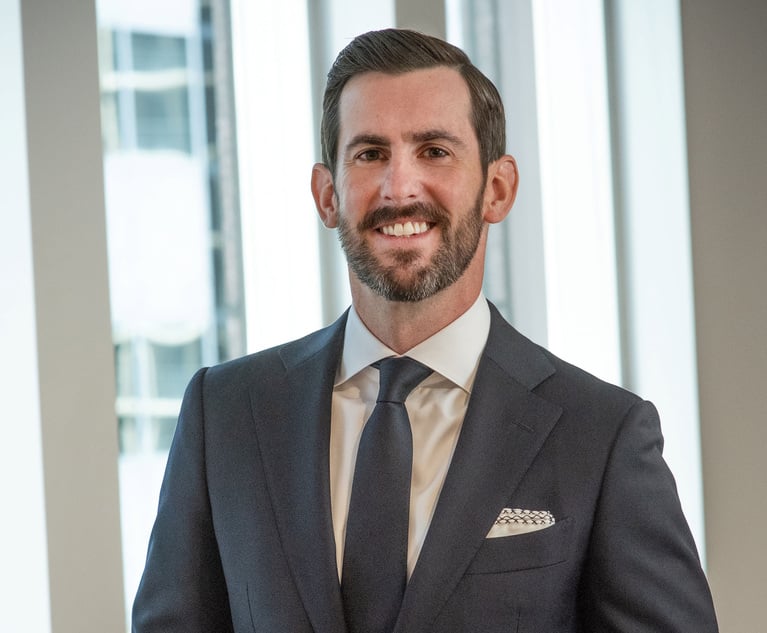Second Circuit Applies Lenient Standards for Certifying Classes in Securities Litigation
On Nov. 6, a three-judge panel of the U.S. Court of Appeals for the Second Circuit issued an opinion in Waggoner v. Barclays, No. 16-1912, 2017 U.S. App. LEXIS 22115 (2d Cir. Nov. 6, 2017), that—if allowed to stand—will make it significantly easier for plaintiffs to obtain class certification in actions alleging violations of Section 10(b) of the Securities Exchange Act of 1934, 15 U.S.C. Section 78j(b), and Securities and Exchange Commission Rule 10b-5 (10(b) actions) against large, publicly traded companies.
December 05, 2017 at 01:42 PM
11 minute read

On Nov. 6, a three-judge panel of the U.S. Court of Appeals for the Second Circuit issued an opinion in Waggoner v. Barclays, No. 16-1912, 2017 U.S. App. LEXIS 22115 (2d Cir. Nov. 6, 2017), that—if allowed to stand—will make it significantly easier for plaintiffs to obtain class certification in actions alleging violations of Section 10(b) of the Securities Exchange Act of 1934, 15 U.S.C. Section 78j(b), and Securities and Exchange Commission Rule 10b-5 (10(b) actions) against large, publicly traded companies. In Waggoner, the court affirmed the district court's class certification order, holding, inter alia, that “direct evidence of price impact is not always necessary to demonstrate market efficiency, as required to invoke [the fraud-on-the-market presumption of reliance permitted under Basic v. Levinson, 485 U.S. 224 (1988)];” and “defendants seeking to rebut the Basic presumption must do so by a preponderance of the evidence.” The court also agreed with the district court that the plaintiffs' damages methodology—which the defendants had challenged—“posed no obstacle to certification.” And while the court rejected the district court's application of the presumption of reliance adopted by the Supreme Court in Affiliated Ute Citizens of Utah v. United States, 406 U.S. 128 (1972), where, unlike the plaintiffs' claims in Waggoner, the claims of fraud were based primarily on omissions, the court determined that such error was harmless.
On Nov. 20, the defendants—London-based financial services company Barclays PLC, its American subsidiary Barclays Inc. (collectively Barclays), and three of their senior officers—filed a petition for partial panel rehearing and rehearing en banc. (A copy of the defendants' petition is available here.) The defendants argue in their petition that the court's holding “that whenever the securities of large, publicly traded companies are at issue, plaintiffs may invoke the Basic presumption of reliance without any direct empirical evidence of 'market efficiency'” conflicts with both the Supreme Court's decision in Halliburton v. Erica P. John Fund, 134 S. Ct. 2398 (2014) (Halliburton II), and the Second Circuit's opinion in Teamsters Local 445 Freight Division Pension Fund v. Bombardier, 546 F.3d 196 (2d Cir. 2008). The defendants' petition also points out that no other court of appeals has reached this “unprecedented conclusion.” In addition, the defendants contend that the panel's holding “that defendants bear the burden of persuasion (not just production), under Federal Rule of Evidence 301, to rebut the Basic presumption” conflicts with the Eighth Circuit's decision in IBEW Local 98 Pension Fund v. Best Buy, 818 F.3d 775 (8th Cir. 2016), creating a circuit split.
Under the governing law, only if the panel agrees with the defendants that it committed legal error and should reverse itself, will it grant defendants' petition for panel rehearing, see Fed. R. App. P. 40(a)(2) (“The petition must state with particularity each point of law or fact that the petitioner believes the court has overlooked or misapprehended …”) And only in extraordinary cases will the court grant a motion for en banc rehearing. As the applicable rule states, such a rehearing “is not favored and ordinarily will not be ordered unless: en banc consideration is necessary to secure or maintain uniformity of the court's decisions; or the proceeding involves a question of exceptional importance.”
Background
Relying in part on the plaintiffs' allegations, the court's opinion recounts the alleged factual basis for the plaintiffs' 10(b) claims against Barclays. According to the court, during the putative class period (Aug. 2, 2011-June 25, 2014), Barclays “operated an alternate trading system—essentially a private venue for trading securities—known as Barclays' Liquidity Cross, or, more simply, as Barclays' LX (LX).” More specifically, LX was part of the alternate trading systems known as “dark pools,” which, according to the court, are popular with institutional investors because they allow investors to trade anonymously and “avoid victimization at the hands of high-frequency traders.” As the court's opinion explains: “High-frequency traders often engage in 'front running' or 'trading ahead' of the market, meaning that they detect patterns involving large incoming trades, and then execute their own trades before those incoming trades are completed. Front running results in the incoming trades being more costly or less lucrative for the individuals or institutions making them.” During the class period, the defendants allegedly made “numerous statements asserting that LX was safe from such practices, and that Barclays was taking steps to protect traders in LX.” Barclays also created a service for its LX customers entitled “liquidity profiling,” which “purportedly allowed Barclays' personnel to monitor high-frequency trading in LX more closely and permitted traders to avoid entities that engaged in such trading.”
On June 25, 2014, (the last day of the class period), the New York attorney general filed a complaint against Barclays, alleging, inter alia, “that many of Barclays' representations about protections LX afforded its customers from high-frequency traders were false and misleading” in alleged violation of certain provisions of the New York Martin Act. On June 26, the price of Barclays' American Depository Shares (ADS), which are available to U.S. investors, fell 7.38 percent. On June 26, news reports estimated that, as a result of the attorney general's action, Barclays could face a fine of more than £300,000,000. On Monday, June 30, Barclays' ADS dropped another 1.5 percent.
Soon thereafter, the plaintiffs filed their 10(b) action in the U. S. District Court for the Southern District of New York, alleging that the defendants had made false statements and omissions about LX and Liquidity Profiling. On April 24, 2015, the district court denied, in part, the defendants' motion to dismiss, Strougo v. Barclays, 105 F. Supp. 3d 330 (S.D.N.Y. 2015).
District Court Decision
The plaintiffs subsequently filed a motion for class certification, supported by an expert report from Dr. Zachary Nye, which addressed, inter alia, the issue of market efficiency, “a necessary prerequisite for the Basic presumption to apply.” Nye's report applied both the five factors identified in Cammer v. Bloom, 711 F. Supp. 1263 (D.N.J. 1989), and the three factors identified in Krogman v. Sterritt, 202 F.R.D. 467 (N.D. Tex. 2001). The report opined that “the seven factors that rely on 'indirect' indicia of an efficient market—the first four Cammer factors and all three Krogman factors”—supported his ultimate conclusion that the market for Barclay's ADS was efficient. The report also opined that an “event study” conducted by Nye met the requirements of the fifth Cammer factor—“whether the price of Barclays' ADS changed when new material information about the company was released”—the only “direct” measure of market efficiency.
In their opposition to the plaintiffs' motion, the defendants argued, inter alia, that Nye's event study was flawed and, therefore, failed to show direct evidence of efficiency under the fifth Cammer factor. They did not, however, challenge Nye's conclusion regarding the seven factors based on indirect indicia of market efficiency. The defendants further argued that, even if the plaintiffs had adequately shown market efficiency, the defendants had rebutted the presumption. As the Second Circuit's decision recounts, the defendants “asserted that the event study conducted by Nye indicated that the price of Barclay's ADS did not increase by a statistically significant amount on any of the days on which the purportedly fraudulent statements had been made. Thus, according to the defendants, there was no connection between the misstatements and the price of Barclays' ADS.”
The district court granted the plaintiffs' motion for class certification, holding, inter alia, that direct evidence of market efficiency was not necessary, and rejecting the defendants' argument that, “without Cammer 5, plaintiffs cannot meet their burden of proving market efficiency by a preponderance of the evidence.” Rather, the court concluded that “indirect evidence of market efficiency—including that a stock trades in high volumes on a large national market and is followed by a large number of analysts—will typically be sufficient to satisfy the Basic presumption on class certification.” The court did concede, however, that, “if there is reason to doubt the efficiency of the market, as when the additional Cammer factors do not weigh heavily in favor of market efficiency (or when defendants' evidence weighs against market efficiency), a plaintiff may have to present direct evidence to establish market efficiency.” In short, the court reasoned that there was no need for direct evidence of market efficiency since “Barclays ADS trades on the NYSE at high volumes with heavy analyst coverage” and, therefore, “plaintiffs have established market efficiency indirectly.”
The court further held that, because the defendants failed to meet their burden of proving a lack of price impact, they had not rebutted the Basic presumption. According to the court, “the fact that other factors contributed to the price decline does not establish by a preponderance of the evidence that the drop in the price of Barclays ADS was not caused at least in part by the disclosure of the fraud at LX.”
Second Circuit Decision
As explained above, the Second Circuit affirmed the district court's class certification order on grounds, inter alia, that the plaintiffs in this case were not required to offer direct evidence of market efficiency in order to invoke the Basic presumption. The court also held that, to rebut the presumption, the defendants were required—and failed—to do so by a preponderance of the evidence, In reaching its decision regarding this second ground for affirming class certification, the court reviewed de novo the question of whether the burden of persuasion shifts to the defendants to rebut the Basic presumption. In its reasoning, the court focused primarily on the Supreme Court's holding in Halliburton II regarding a defendant's right to rebut the Basic presumption. In Halliburton II, the court held that a defendant may rebut the presumption through “any showing that severs the link between the alleged misrepresentation and either the price received (or paid) by the plaintiff, or his decision to trade at a fair market price.” According to the Second Circuit in Waggoner, “the phrase 'any showing that severs the link' aligns more logically with imposing a burden of persuasion rather than a burden of production.” The court reasoned that, “by requiring that the 'showing' defendants must make to rebut the Basic presumption actually 'sever the link' between the misrepresentation and the price a plaintiff paid or received for a stock, the court requires defendants to do more than merely produce evidence that might result in a favorable outcome; they must demonstrate that the misrepresentations did not affect the stock's price by a preponderance of the evidence.”
In addition, the court rejected the defendants' argument that Federal Rule of Evidence 301 (dealing with presumptions in civil cases) precludes the shifting of the burden of persuasion to defendants. According to the court, the Supreme Court adopted the Basic presumption pursuant to the federal securities laws and, therefore, the shifting of the burden is permissible under Rule 301's statutory exception. Moreover, to the extent the Eighth Circuit's opinion in Best Buy can be read as imposing only a burden of production on the defendant, the court stated its disagreement with that conclusion. The court further explained that, because the “extent of the burden was not at issue” in Best Buy given the “'overwhelming evidence'” of no price impact in that case, any such discussion of the burden of proof by the Eighth Circuit was mere dictum and, therefore, not in direct conflict with the court's decision in Waggoner on the appropriate standard of proof.
Implications
In their rehearing petition, the defendants warn that the panel's rulings on market efficiency and rebuttal of the Basic presumption “create a 'rubberstamp' for any plaintiff seeking class certification in a securities case against a large, publicly traded company,” and that plaintiffs will “flock to the Second Circuit, where class certification is now a foregone conclusion.” Although we agree with the defendants' bleak forecast and are not optimistic that either the panel or full court will rehear argument in this case, we anticipate that defense counsel in other circuits will work hard to persuade their courts not to follow this Second Circuit decision and create a circuit split for the Supreme Court to ultimately resolve.
Robert L. Hickok is a partner in the commercial litigation practice group of Pepper Hamilton He can be reached at 215-981-4583 or [email protected].
Gay Parks Rainville is of counsel in the firm's commercial litigation practice group and co-chairs, with Hickok and Los Angeles partner Pamela S. Palmer, the securities and shareholder litigation section of the practice group. She can be reached at 215-981-4952 or [email protected].
This content has been archived. It is available through our partners, LexisNexis® and Bloomberg Law.
To view this content, please continue to their sites.
Not a Lexis Subscriber?
Subscribe Now
Not a Bloomberg Law Subscriber?
Subscribe Now
NOT FOR REPRINT
© 2025 ALM Global, LLC, All Rights Reserved. Request academic re-use from www.copyright.com. All other uses, submit a request to [email protected]. For more information visit Asset & Logo Licensing.
You Might Like
View All
Neighboring States Have Either Passed or Proposed Climate Superfund Laws—Is Pennsylvania Next?
7 minute read
Seven Rules of the Road for Managing Referrals To/From Other Attorneys, Part 2
6 minute read
With New Civil Jury Selection Rule, Litigants Should Carefully Weigh Waiver Risks
6 minute readTrending Stories
- 1Pa. High Court: Concrete Proof Not Needed to Weigh Grounds for Preliminary Injunction Order
- 2'Something Else Is Coming': DOGE Established, but With Limited Scope
- 3Polsinelli Picks Up Corporate Health Care Partner From Greenberg Traurig in LA
- 4Kirkland Lands in Phila., but Rate Pressure May Limit the High-Flying Firm's Growth Prospects
- 5Davis Wright Tremaine Turns to Gen AI To Teach Its Associates Legal Writing
Who Got The Work
J. Brugh Lower of Gibbons has entered an appearance for industrial equipment supplier Devco Corporation in a pending trademark infringement lawsuit. The suit, accusing the defendant of selling knock-off Graco products, was filed Dec. 18 in New Jersey District Court by Rivkin Radler on behalf of Graco Inc. and Graco Minnesota. The case, assigned to U.S. District Judge Zahid N. Quraishi, is 3:24-cv-11294, Graco Inc. et al v. Devco Corporation.
Who Got The Work
Rebecca Maller-Stein and Kent A. Yalowitz of Arnold & Porter Kaye Scholer have entered their appearances for Hanaco Venture Capital and its executives, Lior Prosor and David Frankel, in a pending securities lawsuit. The action, filed on Dec. 24 in New York Southern District Court by Zell, Aron & Co. on behalf of Goldeneye Advisors, accuses the defendants of negligently and fraudulently managing the plaintiff's $1 million investment. The case, assigned to U.S. District Judge Vernon S. Broderick, is 1:24-cv-09918, Goldeneye Advisors, LLC v. Hanaco Venture Capital, Ltd. et al.
Who Got The Work
Attorneys from A&O Shearman has stepped in as defense counsel for Toronto-Dominion Bank and other defendants in a pending securities class action. The suit, filed Dec. 11 in New York Southern District Court by Bleichmar Fonti & Auld, accuses the defendants of concealing the bank's 'pervasive' deficiencies in regards to its compliance with the Bank Secrecy Act and the quality of its anti-money laundering controls. The case, assigned to U.S. District Judge Arun Subramanian, is 1:24-cv-09445, Gonzalez v. The Toronto-Dominion Bank et al.
Who Got The Work
Crown Castle International, a Pennsylvania company providing shared communications infrastructure, has turned to Luke D. Wolf of Gordon Rees Scully Mansukhani to fend off a pending breach-of-contract lawsuit. The court action, filed Nov. 25 in Michigan Eastern District Court by Hooper Hathaway PC on behalf of The Town Residences LLC, accuses Crown Castle of failing to transfer approximately $30,000 in utility payments from T-Mobile in breach of a roof-top lease and assignment agreement. The case, assigned to U.S. District Judge Susan K. Declercq, is 2:24-cv-13131, The Town Residences LLC v. T-Mobile US, Inc. et al.
Who Got The Work
Wilfred P. Coronato and Daniel M. Schwartz of McCarter & English have stepped in as defense counsel to Electrolux Home Products Inc. in a pending product liability lawsuit. The court action, filed Nov. 26 in New York Eastern District Court by Poulos Lopiccolo PC and Nagel Rice LLP on behalf of David Stern, alleges that the defendant's refrigerators’ drawers and shelving repeatedly break and fall apart within months after purchase. The case, assigned to U.S. District Judge Joan M. Azrack, is 2:24-cv-08204, Stern v. Electrolux Home Products, Inc.
Featured Firms
Law Offices of Gary Martin Hays & Associates, P.C.
(470) 294-1674
Law Offices of Mark E. Salomone
(857) 444-6468
Smith & Hassler
(713) 739-1250






